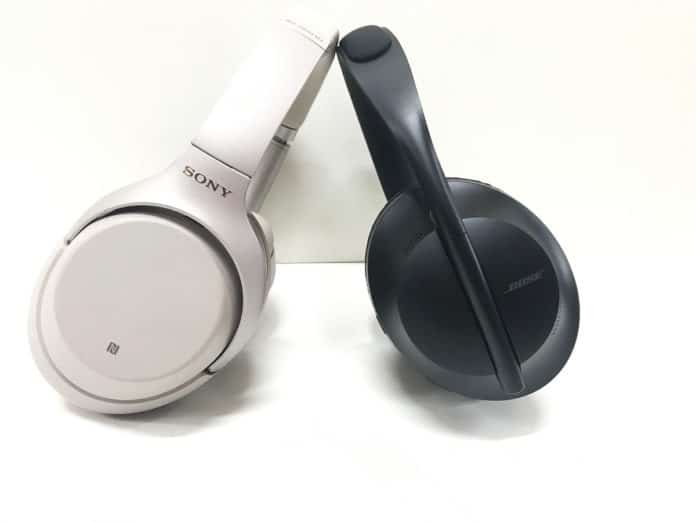It’s a bloodbath. Two companies with great noise-cancellation technology going head to head. Sony has been chasing Bose for a while now, and it’s done some serious catching up. But with Bose’s new release of the 700, the competition is getting even tougher. Which headphone has more effective ANC? Which is more skilled? And which sound profile will better suit your listening style? Let’s find out in this Sony WH-1000XM3 vs Bose Noise Cancelling Headphones 700 Review. Ring the bell.
Sony WH-1000XM3 vs Bose Noise Cancelling Headphones 700 Review
FIT
I found both models equally comfortable to wear. The 700 feels a bit heavier when you’re holding it, but once it was on my head I didn’t notice any difference. I should mention that the Bose 700 sat a bit more snugly around my ears, while the Sony WH-1000XM3 felt a touch looser. So, at the end of the day, it’s a personal preference.


DESIGN
Noise-Cancelling
This one’s a close call. But the active noise-cancellation on the Bose 700 was slightly more effective. “Slightly” being the operative word. Still, the 700 gives you more control in this department, offering 10 different levels of active noise-cancellation. In contrast, the Sony offers only 1 level of ANC. Why is this important? Some people are sensitive to the pressure created by the “noise-cancelling frequencies” being transmitted to the ear. So, it’s a nice option to be able to tone down the strength of the ANC if need be. But both models offer ambient or transparent hearing modes, which allow in the surrounding sound. And ANC can be completely switched off on both models.
Call Clarity
Although both models get the job done (sentences like, “I want a divorce” or “Fluffy died” are clearly audible on both headphones), the 700 offers better call clarity with less interference from ambient noise.
Battery
The Sony WH-1000XM3 wins in this department, offering 30 hours of playtime in comparison to the 700’s 20 hours. But the 700 only takes 2.5 hours to fully charge and will yield 3.5 hours of playtime after only 15 minutes of charging. Unsurprisingly, the WH-1000XM3 takes a bit longer to charge. Around 3 hours. But if you buy the optional power adapter, you can get 5 hours worth of charge in just 10 minutes. You might blow up your city’s power grid in the process, but life is a series of compromises.
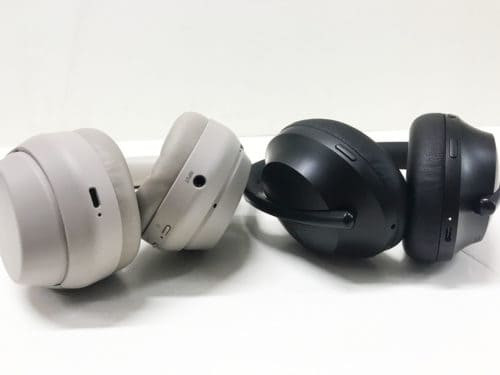
If all else fails, both headphones come with cables for listening in passive mode.
Controls and Functionality
Both headphones employ a touchpad control (as well as a few buttons) on the earcups to control functions, such as play/pause, track skip and calls. Both headphones also allow you to activate your voice assistant and make hands-free calls.
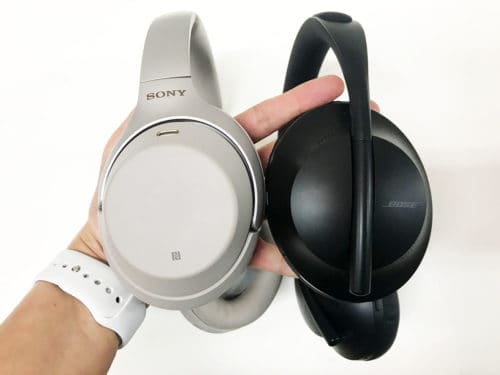
Extra Features
Bose has introduced a new technology called “AR.” In theory, AR allows you to use your Bose headphones to interact with your surrounding environment. Take navigation apps, as an example. Instead of looking at your phone screen for directions, there’s an AR compatible app that gives you information about your surroundings based on your location and where your head is facing. The idea is great; I can look towards a landmark, and my headphones will tell me what I’m looking at. There are also interactive games based on this technology. And I love the idea of less screen time. But unfortunately, in practice, this technology is still working out some kinks. I tried one of these navigation apps in Midtown Manhattan. And the female voice on my Bose 700 spat out 7 different buildings, in quick succession, that were sort of near me. It seems that Bose Lady had a panic attack, and she prefers the country. Anyway, too confusing and not particularly accurate. But I’m sure as “AR” continues to develop, it will be a fun feature to have.
Bose also has a simple app (Bose Sound) that gives you more control over your headphones. For example, you can only switch between a couple of noise-cancelling levels from the headphones themselves. But the app gives you full control of ANC levels, from 1-10.
One advantage that the WH-1000XM3 has over the 700 is that Sony has thrown in an accompanying app that allows you to adjust equalizer settings. A big plus for those who like to play around with their sound signature.
Portability
The Sony WH-1000XM3 may be slightly more portable; the 700 only swivels flat, while the WH-1000XM3 swivels and folds into an adorable little handful. Aww.
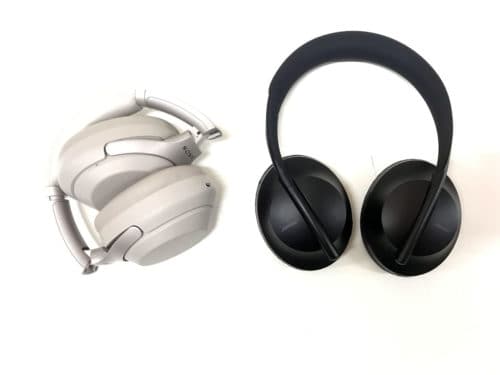
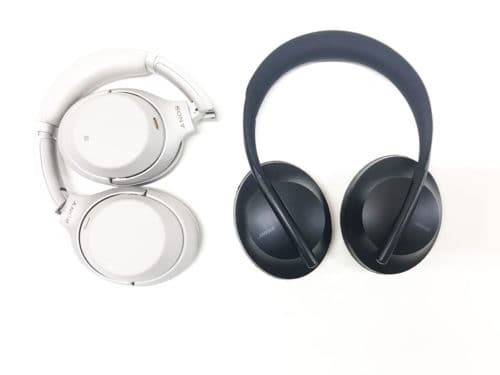
SOUND
Lows
The WH-1000XM3 displays two different bass profiles, depending on whether the ANC is turned on or off. With the ANC turned on, the WH-1000XM3 presents a very forward and meaty low-end, bringing tons of power to pop tracks and lending ample warmth to rock and pop-rock songs. With the ANC turned off, the bass is more tempered and moves further away from center stage. Still, it seems to be the ideal choice modern genres. But as mentioned above, the WH-1000XM3 comes with an app that allows you to adjust equalizer settings. So, it gives you more creative control over the sound signature in general. And based on my lazy research, it doesn’t seem like the 700 comes with that functionality.
But in contrast, the 700 has consistent bass presence regardless of whether the ANC is on or off. And this is a talent that I’ve yet to come across in other noise-cancelling headphones. Unlike the WH-1000XM3, the bass falls closer to the neutral side, offering a clean feel with a more natural tone when it comes to acoustic instruments. So, if you’re primarily listening to genres like classical and jazz, the 700 may be the more suitable option. However, if you like your strings to sound rich and majestic, you might still prefer the weightier WH-1000XM3.
Mids
There are some similarities with respect to balance in this range. But the upper mids feel a more emphasized on the 700. As a result, vocals tend to feel clearer or more forward on the 700, while vocals on the WH-1000XM3 sit more within the mix. So, listening to pop, for example the 700 displays a more dynamic flavor, where the juxtaposition of the low and high frequencies is more pronounced. The Sony, on the other hand, while not as ‘contrasty’ has a lot more fullness, giving rock and pop-rock tracks a yuge, expansive feel. And because Sony’s sound signature is darker, those with sensitivity to higher frequencies might find the WH-1000XM3 to be an easier listening experience. But in terms of clarity and separation, the 700 seems to be the more precise headphone, at least when you listen to intricate arrangements. Folk music, for example, sounded tidier and more articulate on the 700; guitar strums that felt a little mushy/bloated on the WH-1000XM3 were cleaner or more delineated on the 700. So, if you’re somewhat of a critical listener, you’ll probably prefer the accuracy of the 700.
Highs
Again, there’s no question that the 700 is the brighter headphone of the two models. And most people fall into one of two categories; those who like their highs snappy and sparkly, and those who find these frequencies tiring on the ears. If you’re in the latter group, then you should certainly opt for the WH-1000XM3. But if you listen to a lot of pop, for example, and you like percussion to sound crispy and vibrant, then you may get more pleasure out of the 700. And in terms of sheer skill, the 700 certainly beats the WH-1000XM3. For example, listening to classical music in this range, violins were a lot more transparent and nuanced than the comparatively smoothed-over sound of the WH-1000XM3. And this was true for vocals as well, with the 700 revealing more breath and subtleties in vibrato.
Soundstage
You’ll feel a bit more spaciousness on the 700, compared to the relatively compact soundstage of the WH-1000XM3. And though both headphones give you a decent sense of dimension in terms of depth and height, the instrument placement on the 700 feels a bit more precise, perhaps because the separation is superior.
SUMMARY
If you like it rich and meaty, and/or you want some control over your sound profile, go for the Sony WH-1000XM3. But if you prefer a lighter, brighter feel, and you’re a sucker for detail and clarity, it’s hard to beat the Bose Noise Cancelling Headphones 700. That being said, if all you’re looking for is the strongest ANC on the market, the choice becomes more difficult because these two models are almost equal in this respect. And for this group, the deciding factor may come down to functionality and price. Yes, the WH-1000XM3 is 7 beers cheaper.
You can find both of these headphones for the best price here:
Bose Noise Cancelling Headphones 700 on Amazon
Curious to see how these headphones rank on our ranking tool?
For questions and faster response on the article please feel free to drop by our headphone forum.
MAJORHIFI may receive commissions from retail offers.


